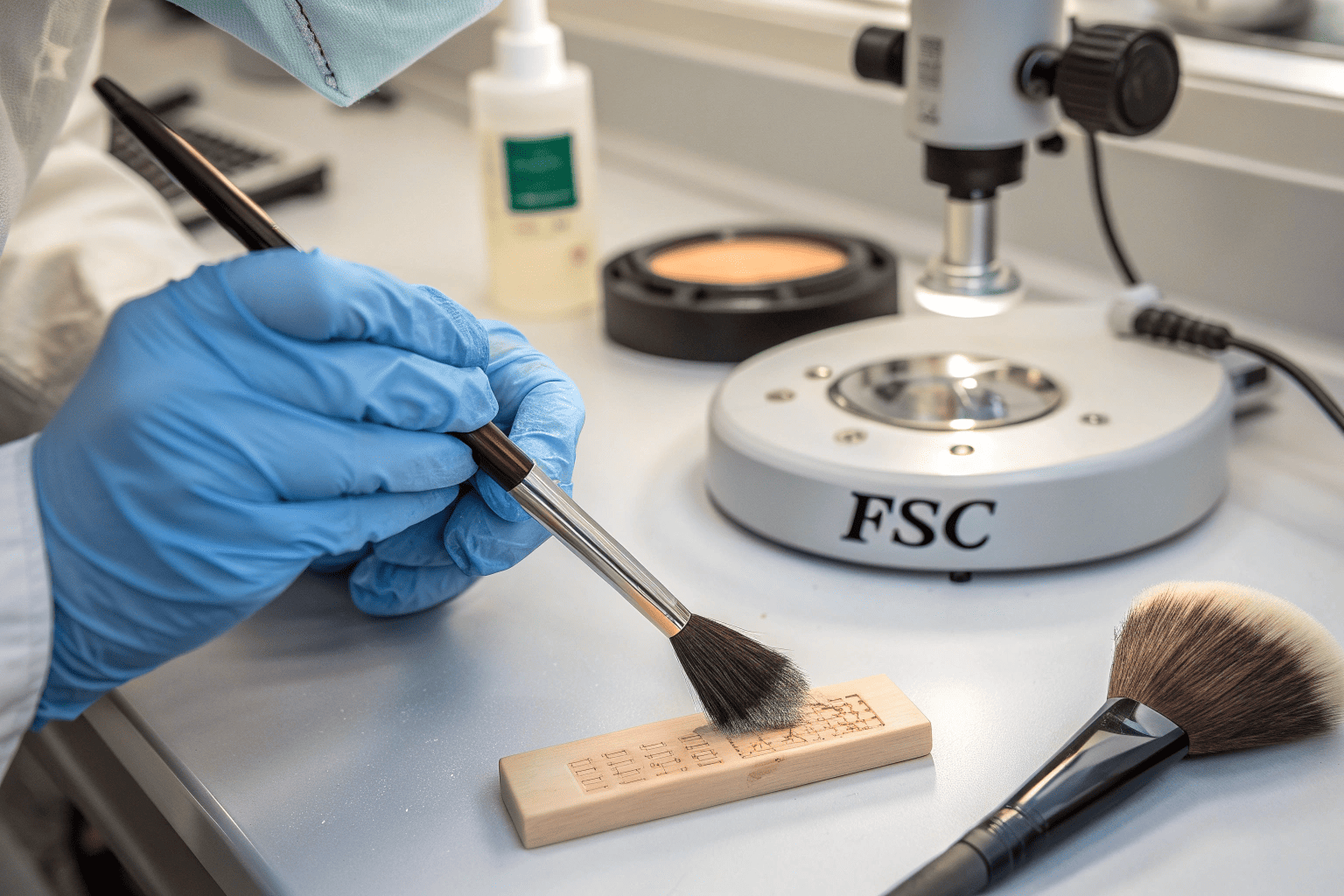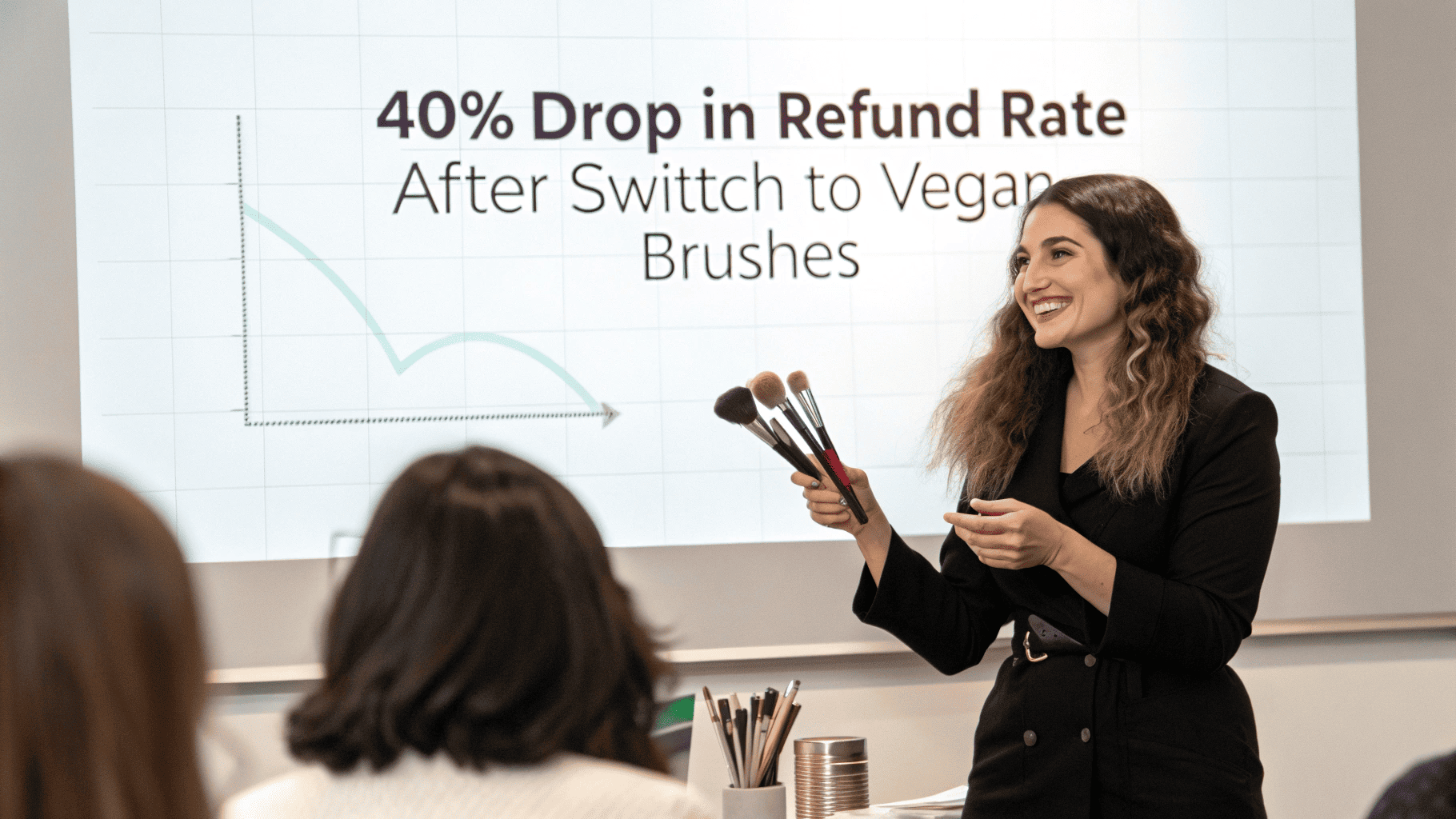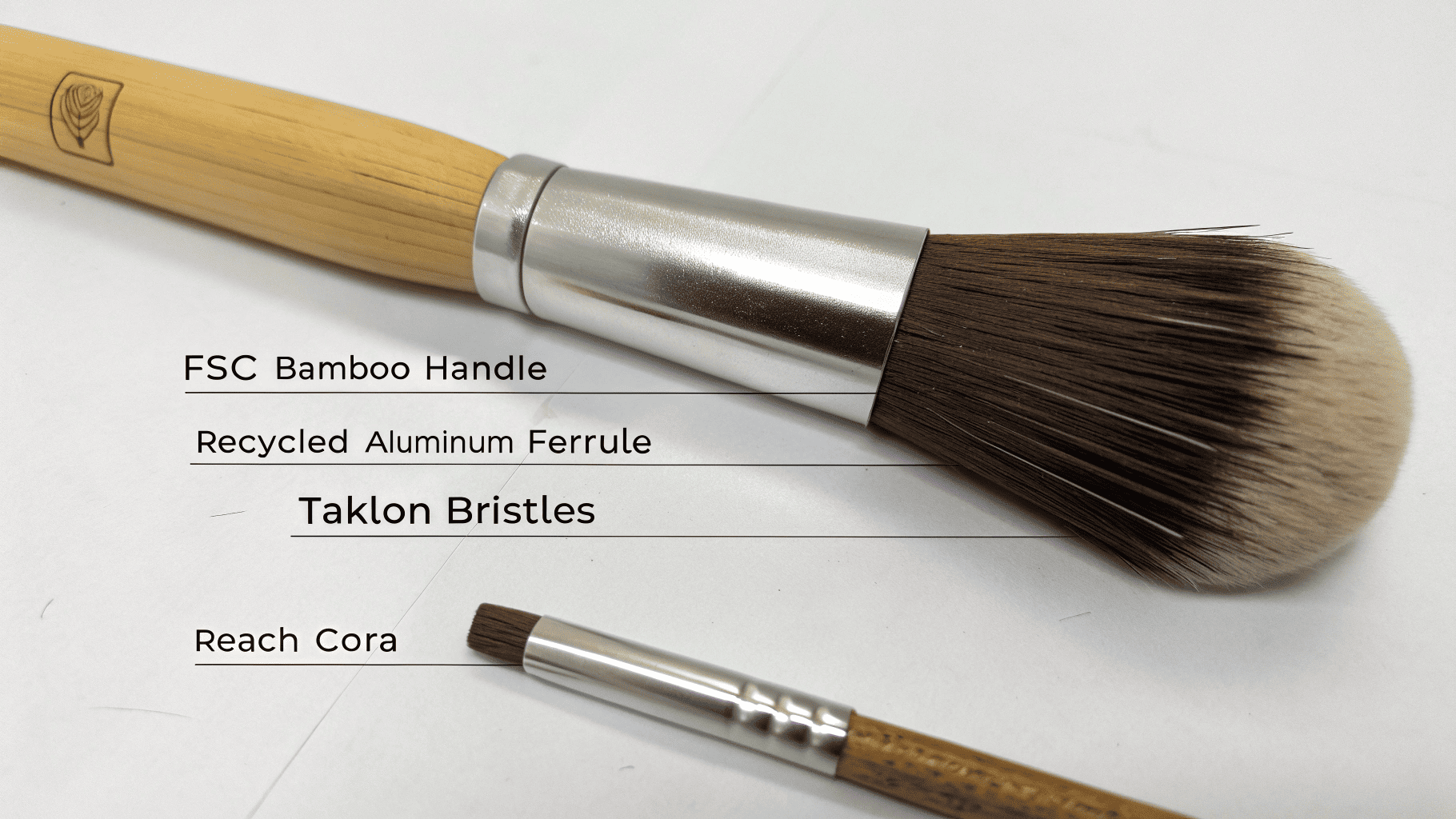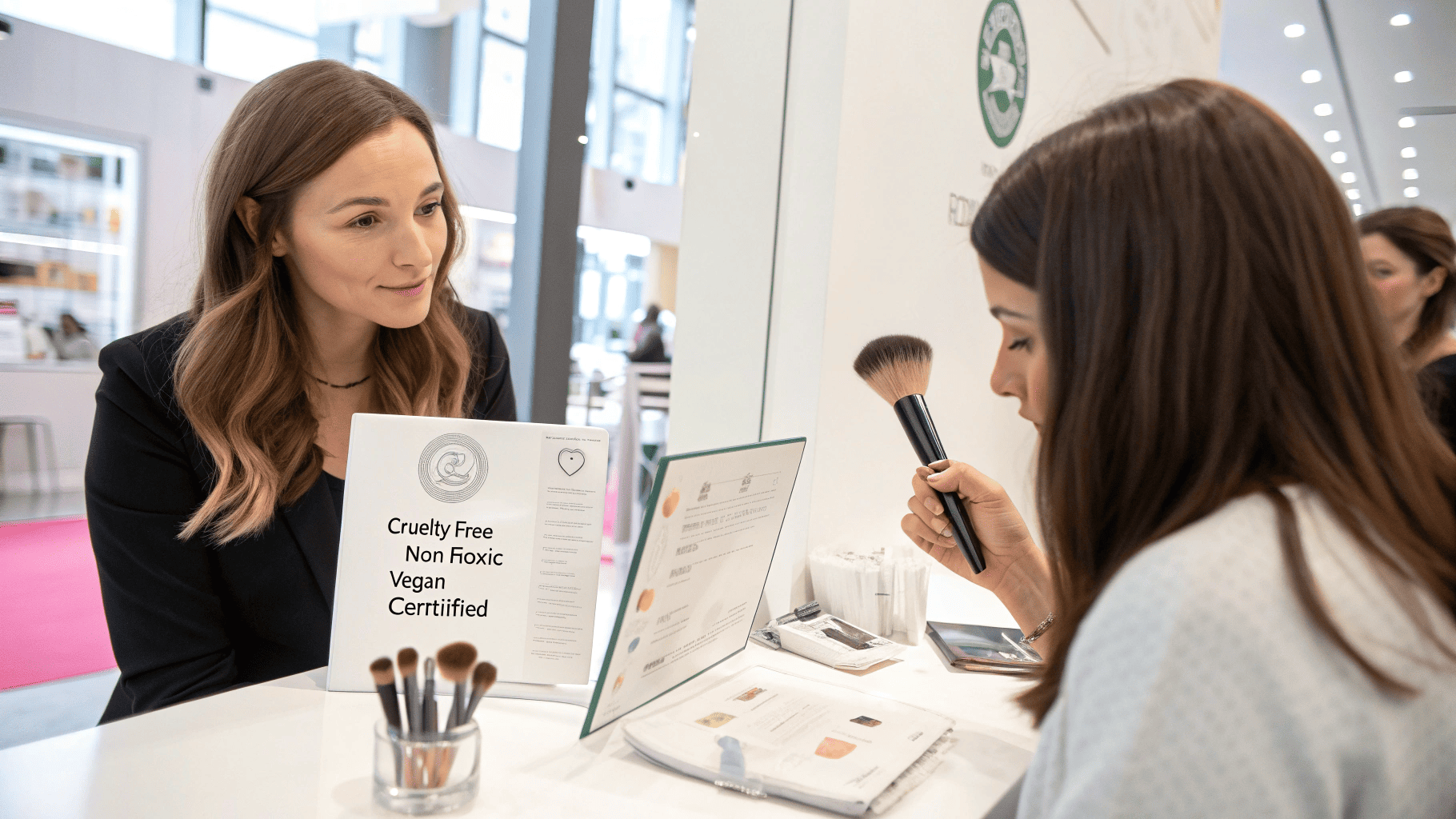Have you ever trusted a “green” brush supplier, only to discover toxic glue in lab tests? One of my clients did — and it ruined her launch. That moment made me rethink everything about what “non-toxic” really means in makeup tools.
Non-toxic makeup brushes are made with safe materials like Taklon, FSC-certified wood, and recycled aluminum. They skip glues, harsh coatings, and animal hair—making them safer for skin, healthier for people, and better for the planet.

Lab quality test of FSC certified makeup brush
That moment changed how I guide my clients. Let’s go deeper — because when it comes to brush safety and brand trust, surface claims are never enough.
What are the most eco-friendly makeup brushes?
A clean label on packaging doesn’t mean the whole brush is clean. I’ve seen handles made from sustainable bamboo but painted with petroleum-based lacquer. Brands want to do better, but don’t always know where to look.
Eco-friendly brushes use bamboo, recycled aluminum, and synthetic bristles like Taklon. They’re cruelty-free, durable, and reduce waste. That’s what makes them truly green.

What makes non-toxic makeup brushes safer for skin and health?
Makeup brushes touch skin every day but are rarely tested like skincare. The Environmental Working Group (EWG)1 has found that low-cost brushes often contain glues or dyes that trigger allergic reactions. Dermatologists cited by Allure also warn of bacteria and toxins in poorly made brushes. In contrast, non-toxic brushes2 use hypoallergenic bristles, nickel-free ferrules, and safe coatings. These details may seem small, but for brands focused on sensitive-skin users, they matter more than ever.
| Material | Why It’s Eco-Friendly | Benefit |
|---|---|---|
| Bamboo | Fast-growing, renewable | Lightweight, biodegradable |
| Recycled aluminum | Less mining, reused metals | Durable, low-impact |
| Taklon fiber | Synthetic, vegan | No animal cruelty, easy to clean |
Are synthetic makeup brushes toxic?
A lot of indie founders hesitate when they hear “synthetic.” They worry about microplastics or harsh dyes. I get it — I used to think the same until I learned how synthetic fibers have evolved.
Synthetic brushes are typically non-toxic and safer than animal hair brushes, especially when manufactured without glue or harsh chemicals.

Performance-wise, quality synthetics outperform animal hair in durability, hygiene, and cost-efficiency. A 2022 study from Mintel found that 68% of Gen Z and millennial consumers preferred vegan tools3 for both ethical and functional reasons. Brands switching to Taklon report fewer returns and better long-term customer satisfaction. One founder told me: “Our refund rate dropped by 40% once we switched to certified vegan brushes.”
| Feature | Traditional (Animal Hair) | Non-Toxic Synthetic |
|---|---|---|
| Hygiene | Traps bacteria | Easy to clean |
| Allergies | Common for sensitive users | Hypoallergenic |
| Ethics | Often cruelty-involved | 100% vegan options |
| Consistency | Batch variation common | Uniform bristle quality |
What is the safest material for makeup brushes?
Your brush handle may feel nice, but what’s inside? Many cheap brushes hide glue cores, coated aluminum, or mystery fibers that your customer touches every day.
Safe materials include bamboo, aluminum ferrules, and synthetic (vegan) bristles4, which reduce allergens and avoid animal cruelty.

Let’s break this down by each component. According to REACH5 compliance standards and the European Chemicals Agency (ECHA), any material in contact with skin must be free from substances like nickel, lead, or phthalates. That’s why more brands are switching to certified, traceable materials. Here’s a side-by-side comparison of common brush components:
🧾 Makeup Brush Material Comparison Chart
| Component | Material | Toxicity Level | Eco Rating | Suitable For | Comments |
|---|---|---|---|---|---|
| Bristles | Taklon (Synthetic) | ✅ Non-toxic | ⭐⭐⭐⭐ | Vegan brands, allergy-prone skin | Easy to clean, consistent softness |
| Bristles | Corn silk fiber | ✅ Non-toxic | ⭐⭐⭐⭐⭐ | Sustainable, plant-based products | Biodegradable, rare but rising |
| Bristles | Goat/Sable hair | ❌ Potential allergens | ⭐ | High-end brands | May cause irritation, non-vegan |
| Handle | FSC-Certified Wood6 | ✅ Non-toxic | ⭐⭐⭐⭐⭐ | Luxury & eco brands | Requires non-toxic coating |
| Handle | Natural Bamboo | ✅ Non-toxic | ⭐⭐⭐⭐ | Clean beauty brands | Lightweight, fast-growing |
| Ferrule | Recycled Aluminum | ✅ Non-toxic | ⭐⭐⭐⭐ | All product tiers | Durable, low-impact material |
| Ferrule | Plastic (non-recycled) | ⚠️ Often contains glue/dyes | ⭐ | Budget tools | Usually avoided in clean brands |
Why choose non-toxic makeup brushes?
If your brand speaks clean beauty, your tools can’t whisper toxicity. Brushes aren’t just accessories — they’re the first thing your customer feels on their face.
Non-toxic brushes reduce skin irritation, environmental impact, and align with cruelty-free and clean beauty values

Safe tools protect your brand. They build confidence and reduce risk. The Global Cosmetics News7 recently noted a rise in safety litigation for tools with unlabeled toxins. That’s a nightmare no small brand wants. By choosing certified materials and transparent partners, you future-proof your brand. My clients often report better reviews, smoother launches, and stronger partnerships with retailers who demand documentation.
How can I identify truly non-toxic makeup brushes from labels?
Labels that matter include:
- PETA / Leaping Bunny Certified8 (for cruelty-free claims)
- FSC9 (for sustainably harvested wood)
- REACH/ISO (for toxic substance control)
- MSDS availability10 (for full ingredient breakdown)
If a vendor can’t show you proof, they’re not clean. I always advise founders: don’t buy a brush unless you’d feel safe using it on a child.
| Label | What to Check | Why It Matters |
|---|---|---|
| Vegan | No animal hair, no animal testing | Ethical compliance |
| FSC | Wood from sustainable forests | Eco credibility |
| ISO / REACH | No banned substances | Health + trade compliance |
Conclusion
The safest brushes aren’t just good for your customer’s skin — they’re smart for your brand’s future. If you’ve been wondering where to find real non-toxic options, I’ve helped founders just like you navigate the confusing claims. Let’s make your sourcing clean, fast, and honest — so you can stop guessing and start building.
-
Explore the EWG’s insights on makeup safety and ingredient transparency, crucial for informed choices. ↩
-
Discover the advantages of non-toxic brushes for skin health and eco-friendliness, essential for conscious consumers. ↩
-
Discover the reasons behind the growing preference for vegan tools among consumers, especially Gen Z and millennials. ↩
-
Explore the advantages of synthetic bristles, including their hypoallergenic properties and cruelty-free nature, making them ideal for sensitive skin. ↩
-
Understanding REACH compliance is crucial for ensuring the safety and quality of makeup products, including brushes. ↩
-
Learn about the significance of FSC-Certified Wood in promoting sustainable practices and ensuring eco-friendly beauty products. ↩
-
Explore Global Cosmetics News for the latest updates on safety regulations and trends in the beauty industry, crucial for informed brand decisions. ↩
-
Learn about the significance of these certifications in ensuring cruelty-free beauty. ↩
-
Understanding FSC certification helps ensure your makeup brushes are eco-friendly and sustainably sourced, aligning with clean beauty values. ↩
-
Understanding MSDS availability helps ensure safety and transparency in cosmetic products, crucial for informed consumer choices. ↩

